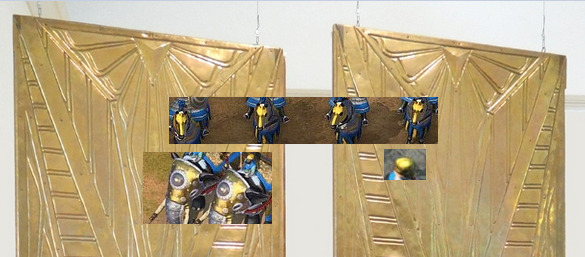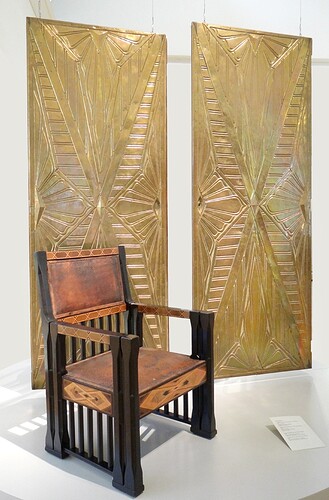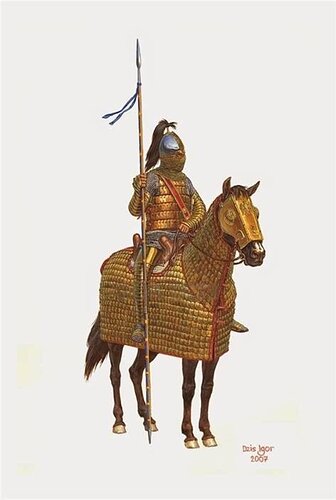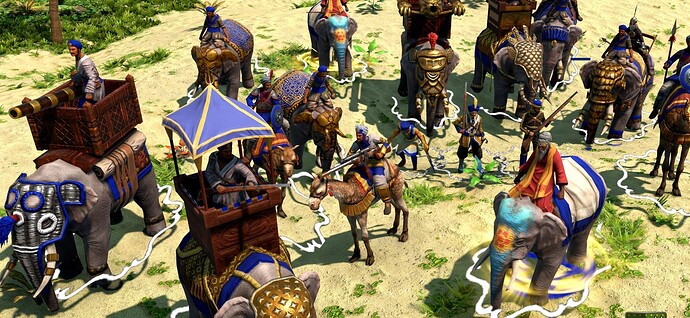If it’s supposed to be brass or bronze ever, maybe bringing in some oranges and browns into the mix would help. I don’t know how yellow the gold should be, but maybe a little less yellow or more reflectivity or spec hits would help sell the believability of its value? Just thoughts. I’d need to watch some hi-rez gameplay vids
Brass is very brittle and would not make a good armor. but could be used in adornments.
Bronze can make good armor but is does need to be thicker and thus heavier than steel/ iron armor.
While copper is very prevalent the cost and scarcity of bronze comes from the tin which is much more scarce. and Had to be traded long distances.
There was no aluminum in this time period so any aluminum bronze would be unheard of. Its main purpose today is in components that require very little oxidation as aluminum bronze does not patina easily and stays very bright.
Early iron age swords were inferior to good bronze (could be work hardened) but the cost caused iron tools to gain in popularity and soon the quality also increased, putting bronze out of fashion.
Good bronze is underestimated and the Chinese perfected this even more with dual alloy swords with cores of soft bronze and very hard (higher tin content) in the edges. But overall is an an inferior metal to use for armor and weapons and also cost a lot more.
Armors were gilded in gold leaf but this was a very expensive process.
Common armors would also have been blackened, or painted to help preserve them and help distinguish them.
This is not necessarily correct - in the Medieval period there was not a known distinction between tin and alluminum. So some alloys used alluminum without the smiths in question ever knowing it. This is why certain ores were more highly valued than others just because “Hey, this stuff makes good swords!” without any deep knowledge other than “If you keep making it hot it’ll glow and then you can shape it!” Medieval alloys were not based on an actual science until the 15th century so it’s hard to really say what the chemical composition of various weapons and armor really is.
Also note I was just using alluminum bronze as an extreme example. The point is: bronze is a lot stronger than people often give it credit for. People believe iron replaced bronze because it was stronger - nope, it was just cheaper. Particularly in western Europe.
Many alloys of brass are brittle and, by modern alloy standards, would make horrible armor. Then you remember other people were making armor out of iron. >Iron.< Not steel. Brass actually was ok in comparison to that. This would change later, but Abbasid caliphate died out before the age of metallurgy.
I know that artwork from the period often depicts Muslim fighters wearing and I’ve seen museum pieces of bronze and brass llamelar and splint mail (as well as steel chainmail with brass ornaments… though that was a post-crusade piece). I also believe, if memory serves, that Damascus had large copper mines and that the famous Damascus swords were a steel weave with copper dispersed throughout.
So they had access to copper and we have some evidence of them using it. Was it so prevalent that every single man with a camel could afford it? Eh… if you could afford a camel you could probably afford bronze so it’s within possibility but it’d make more sense if only some kind of elite guard wore colors like that. Like if you say the Caliph’s guard all decked out in brass you’d probably be like, “Yeah, they are just trying to look snazzy.” So I get the complaint that there is a bit too much brass/ bronze/ gold, but it’s far from being wrong.
In the Middle-east it was more common to make armor white (because white reflects the sunlight which then reflects heat) so soldiers wouldn’t be so hot. That would be a cool alternative to just bronze or brass everything, I agree.
The tint is not necessarily wrong. There are alloys of both brass and bronze with a very vibrant yellow sheen. These plates in the background are bronze.
But I don’t disagree with a color change if they gave it a more copper sheen. Though I am biased because I love the look of copper.
I think your photo demonstrates what I was trying to say, though. The ‘gold’ in the AoE4 examples above is very yellow and saturated compared to your photo. The elephants’ gold color are better, though (closer to your photos):

There was a knowledge of Alum, a oxide of aluminum but never any recorded history of them knowing about it as a metal, they saw it as a type of salt and used it for dying wool and a few other things. The process to actually get a refined aluminum metal is pretty complex and when discovered was worth more than gold. It takes electricity to separate the bonds of the oxides. It is not fair to say they used it if all it was is a contaminated alloy. Where are you getting the information that they knew about aluminum metal? Aluminum is abundant but its all trapped in oxides. Me thinks if you put alum into hot bronze its just going to all float to the top as slag.
All these things can be proven and tested, so where is the evidence of aluminum bronze alloys in any age? Perhaps the Chinese may have a few mysteries… but no definitive evidence.
Yes bronze is much stronger than people think, but very expensive. (even today) I also think one under estimated quality is that it is low friction since it is so much softer, so it actually kind of lubricates itself when making cuts in metals. Iron generates quite a lot of friction.
The thing with armor is, that metal makes much better armor than it does for weapons, in that a lightly tempered or even mild steel sheet is very difficult to cut through even with a hard sharp object. So even small plates of brass, hardened leather, layered textiles, linothorax type lamination, wood, etc… make for pretty effective armors. So could one make a brass plate armor? (smaller scale would be best) sure… but it wont deform well, and will tear easily if a big breastplate.
I have never heard of a damascus sword being a layering of copper. Are you talking about wootz steel? (damascus is often what modern people call pattern welded steel)
Wootz is a crucible steel, They would take various pieces of foundry blooms load them into a crucible and add plant material for more carbon. They would then seal these up and slow fire them, and then get them super hot to melt the steel again, and absorb the carbon to a high content. Then the crucibles were buried and allowed to cool very slowly. This created the special wootz grain structure. And by very carefully controlling the heat by not over heating or working the material too cold could make a wootz style “Damascus” (its origin) blade that was superior to all others at the time.
Pattern welded or commonly referred to as damascus do to similar swirly patterns in the grain is made by forge welding various pieces of bloomery steel together to homogenize the high and low carbon together to make the steel as one piece. Common misconception is that it makes it stronger, (which in the time it did as steel was not as uniform) but modern uniform alloys of steel are the strongest metal can get. (with proper heat treatment)
Copper and steel do not stick well this way due to oxides, and possibly temperature differences. . Copper is really difficult to weld to without a brazing alloy. Though I have seen one modern smith make some damascus with copper, and most people including myself were blown away by it and the process was incredibly complex. And I think all it added was for aesthetics and “woo” factor.
Agreed, but for some reason in AoE 4 its not looking any good. I cant tell why, but it feels weird, they have to do a good balance and select very well and with basis what parts are going to be gold.
This game has really big problems in the design department, I am so upset to be honest…
nice example
those 2 colors are off, i wonder if it could be different graphics settings, or if at some point to streamline performance scaled the textures down.
The elephants look pretty good, and I do like how it can differentiate the elite unit status but the yellow gold is a little much, particularly with all the other gold elements and effects.
I didn’t say this. Reread my post.
I guess I read into it, because they “valued certain ores more” sorry for that, please forgive… but I do ask for the evidence of high quality tin being confused with metallic aluminum in any way. Or ancient bronze found to have high amounts of it as prized from a mine that has metallic aluminum. There are many other contaminants that can rate the quality of alloys. Aluminum oxides would just show up as slag in any crucible to my understanding, as it requires electrolysis and a reaction with carbon to release the oxide bonds.
Unfortunately I can’t comply because proving this would require interviewing smiths from hundreds to thousands of years ago and they are currently very busy with their new past time of being dead.
That and discussions on chemical analysis of medieval arms and armor goes way beyond the original scope of this discussion (which is just on armor being a bit too gold looking), and - as I said - I was just using aluminum bronze as an example of a strong bronze because the argument of “iron > bronze” came up. As much as I would love to rant about ores and how little we really know about ancient and medieval forging or ore processing… a game forum of AOE4 is not really the place for it.
I get that you were mentioning aluminum bronze as a very strong alloy, but to not confuse anyone reading this that might have thought you meant it as a real alloy of ancient bronze I had to comment that it did not exist at that time.
To which you said I was not really correct. (that aluminum bronze was a thing whether they knew it or not), but apparently there is no evidence of this so it is not really something worth saying and should have left it at aluminum bronze did not exist at the time i used it as an example of alloys of bronze that can match the strength of some low alloy steels.
There is also another error in here because bronze tools are generally not forged (bronze can be forged but its tricky and casting is more efficient) but cast into shape, ground down, and then work hardened cold by hammering the blade edges, so that the core stays soft and the edges get a little harder. So in manufacture the metal only gets hot once.
Somewhere to say this you must have learned about aluminum being a component of medieval ancient bronze either through written accounts or from spectral analysis. So you should have a source of artifacts that had high aluminum content. In my research there was mention of some Chinese belt buckles found in a tomb. But not much is really known about them or how they could have been made.
I could definitely support a higher tech society of each with proper evidence. There are plenty of out of place artifacts to suggest a lot more was going on in ancient times.
Here’s a byzantine cataphract in full bronze armor. Which reminds me… Where are the byzantines in this game?
coming soon TM as a DLC
In many cases the amount of gold isn’t horrendous. But lack of general detail in models and especially- textures and areas dedicated solely to represent player allegiance (color blobs) makes that precious metal (gold or anything else- doesn’t matter) stand out much more. In general, it’s not bad, but some unit models just look too plain and these player colours and gold stand out more than they should or are needed to.
I’m not a fan of a rigid rock-paper-scissors design, both in-game balance and visuals. AoE players aren’t mentally handicapped and don’t need to be constantly slapped in the face with elements like that, or mentioned in many other threads, size of weapons.
You can have ‘gold’ and shiny things and have them appear reasonable and toned down at the same time.


